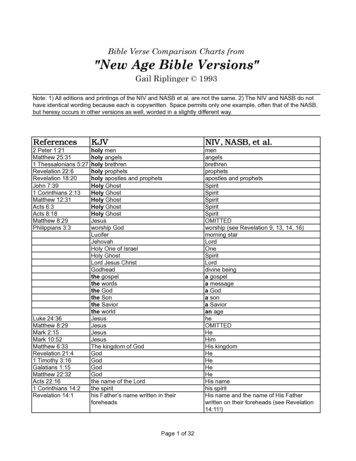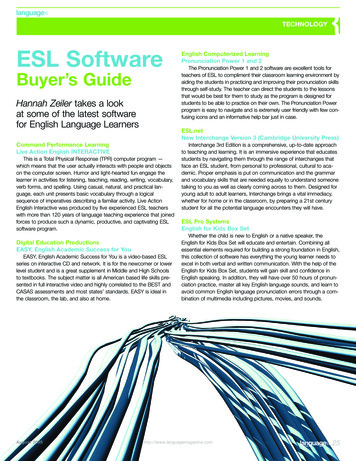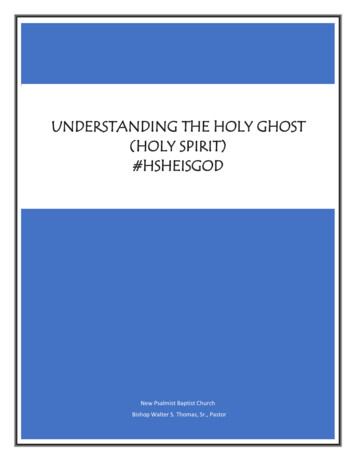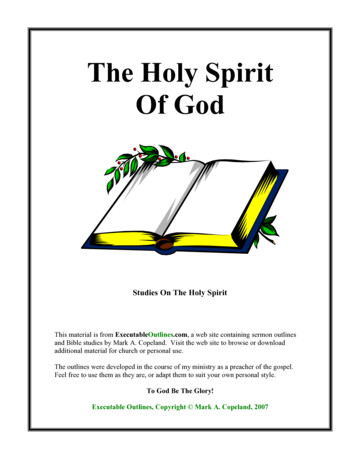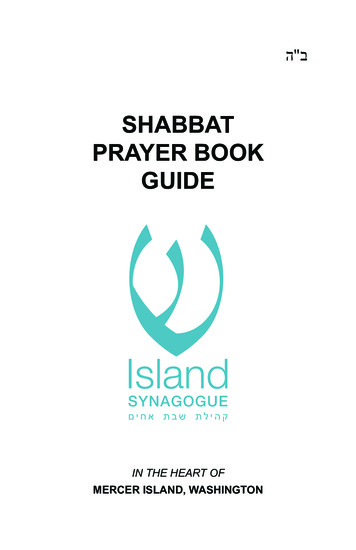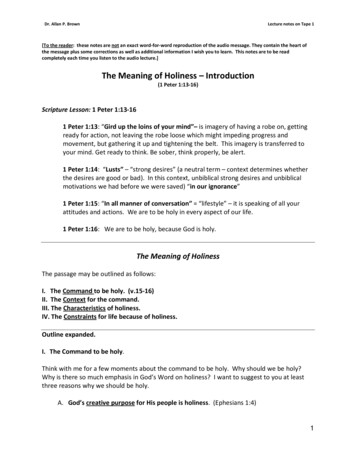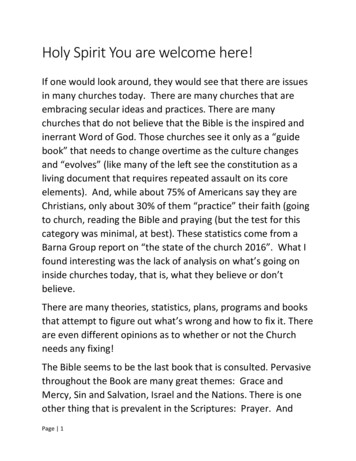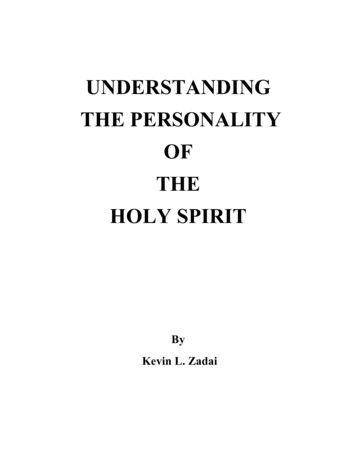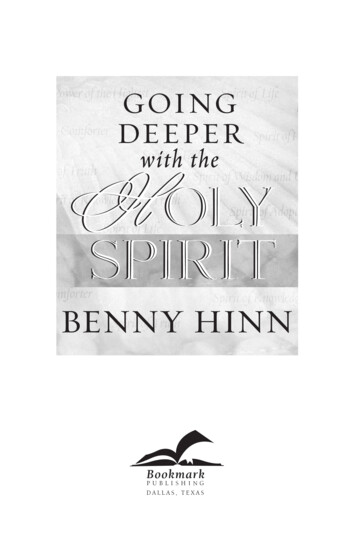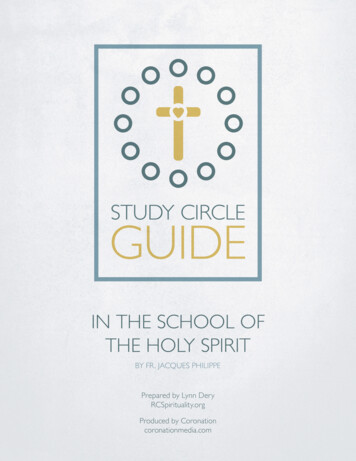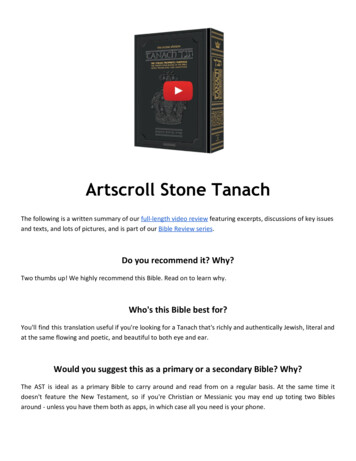
Transcription
Artscroll Stone TanachThe following is a written summary of our full-length video review featuring excerpts, discussions of key issuesand texts, and lots of pictures, and is part of our Bible Review series .Do you recommend it? Why?Two thumbs up! We highly recommend this Bible. Read on to learn why.Who's this Bible best for?You'll find this translation useful if you're looking for a Tanach that's richly and authentically Jewish, literal andat the same flowing and poetic, and beautiful to both eye and ear.Would you suggest this as a primary or a secondary Bible? Why?The AST is ideal as a primary Bible to carry around and read from on a regular basis. At the same time itdoesn't feature the New Testament, so if you're Christian or Messianic you may end up toting two Biblesaround - unless you have them both as apps, in which case all you need is your phone.
How's this version's relationship with the Jews and Judaism?Excellent. This translation will bring you closer to the Jewish people, and significantly enhance yourappreciation for traditional Judaism.A small example of how this Bible will deepen your acquaintance with traditional Judaism is how, at the end ofeach of the books of the Torah, it says chazak, chazak, v'neet'chazeyk! ( be strong, be strong, and may we bestrengthened!) This rousing cheer is traditionally said by Jewish people upon completion of each book of theTorah.Another small example is how the books of Isaiah, Malachi, Lamentations, and Ecclesiastes conclude on a lownote, so a positive verse from earlier in the chapter is appended to the end so the readings always end on ahigh note.Who's the publisher and when did it come out?This Bible was first published in 1996 by Artscroll, an Orthodox Jewish publishing companythat has been so successful in revitalizing American Jewish religious life that its impact hassometimes been called the "Artscroll revolution". Artscroll's books are especially popularwith ba'alei teshuvah - Jews returning to the faith - and with Christians desirious oflearning more about Judaism.Along with Artscroll's prayerbook (which we highly recommend) and Talmud series, theArtscroll Tanach is one of their most popular works.Who translated it and what's their story?The primary translator and editor was Rabbi Nosson Scherman (to the right), who wasaided by Rabbi Meir Zlotowitz with whom he founded Artscroll in 1976 (to the left), andtwo other Rabbis. One need only read Rabbi Scherman's introduction to the AST tosense his spiritual depth and richness. His gift for expressing spiritual concepts withflowing poetic beauty and crisp lucidity is almost overwhelming. Watch the video reviewfor examples.Is it more word for word or thought for thought?The AST is a very literal translation. Technically speaking, it's a "formal equivalent". Not only is it very word forword, it also carries over the grammatical patterns of the Hebrew original into the English sentence structure.What's surprising is how this translation still flows and is easy to read, in contrast with other literal translations
that can be stiff and hard to follow.An exception to this otherwise literal translation is the Song of Songs, which is embellished as an allegoricaldescription of God's relationship with Israel according to Rashi's interpretations, with the actual text discreetlytucked away in the footnotes.Watch the video review for examples of Hebrew syntax in the English and allegorical interpretations of Song ofSongs.How are Hebrew names written?Personal names are written in their traditional Anglicized form. For instance, Abraham, Isaac, Jacob, Rebekah,Moses, Joshua, Abigail, Solomon, and Isaiah.Geographical names are also written in their traditional Anglicized form. For instance, Jerusalem, Hebron,Bethlehem, and Babylon.How are Hebrew book names written?In the Hebrew/English version the names of the books of the Bible are written in their traditional Anglicizedform - for instance, Genesis, Exodus, Joshua, and Psalms - and are also written in Hebrew.In the English-only version, both the traditional Anglicizedforms and an Ashkenazi transliteration of the Hebrewforms are written side by each. In this construct Hebrewwords are written with a compromise between theSephardi and Ashkenazi pronunciations. The more properSephardi vowels are used, but "t" on the end of words iswritten as "s", following the Ashkenazi pronunciation Shemos, Joshua/Yehoshua, and Psalms/Tehillim,and Writings/Kesuvim.How are the names and titles of God written?In the Tanach God's name is circumlocuted as HASHEM, which literally means THE NAME.Elohim is rendered as God, Adonai Yhwh as "My Lord, HASHEM/ELOHIM", Adonai as My Lord, El Shaddai issimply transliterated as El Shaddai, El Elyon as God, the Most High, El Kana a s jealous God, and Yhwh Tzvaot as
HASHEM, Master of Legions.Ruach Yhwh is the spirit of HASHEM, and ruach kodshecha is Your Holy Spirit.How are key terms in the Tanach rendered?Acharit ha'yamim is translated end of days, chag as festival, chesed a s kindness, chukah as decree, chukatolam as eternal decree, emet a s truth, emunah as faith, hasatan as the Satan, matzot as matzos, mikra kodeshas holy convocation, mishpat a s ordinance, mo'adim as appointed festivals, pesach a s pesach-offering,shabbaton a s rest day, sheol as the grave, sukkot a s sukkos, tahor as clean or uncontaminated, tamei ascontaminated, teruah a s shofar blasts, torah as as Torah, totafot a s ornament, tzedakah a s charity, tzitzit astzitzis, and kippod as hedgehog.How are the Messianic prophecies interpreted?Watch the video review for an in-depth discussion of how the verses predicting the Mashiach's coming areinterpreted in the AST, why traditional Judaism is actually very "Messianic", and why Orthodox Jews have abetter idea than most Christians of what the world will look like after Messiah comes!Does it also have the Hebrew text?The original Hebrew text is included along with the English translation. There isalso an English-only version that, if you can believe this, doesn't have as manypages in it. Similarly, Artscroll has recently released a Hebrew-only version.The Hebrew text contains the holy name of God, spelled with the four lettersyod/hei/vav/hei. Something to remember if you're coming from a non-Jewishbackground is that a book containing God's name has the status of a holy book inJudaism, and is to be handled in a very reverent way. On a practical level thatmeans you should never put it on the floor, or put anything on top of it. If aJewish person saw you mistreating a holy book in such a manner, they would behorrified. In such situations the instructions of the apostle Paul in 1 Corinthians10:32 to "give no offense either to Jews or to Greeks or to the church of God"certainly apply.
Does it open from right to left, or from left to right?The Hebrew/English version opens from right to left, like an exciting Jewish sefer. The English-only versionopens from left to right, in boring English fashion.Are the books in the Jewish or Christian order?The books are in the traditional Jewish order of Law, Prophets, and Writings. Thechapters and verses are also numbered according to Jewish tradition.For a detailed explanation of the differences between Jewish and ChristianBibles, watch our review of the Complete Jewish Bible .Are the chapters and verses in the Jewish or Christian order?The books are in the traditional Jewish order of Law, Prophets, and Writings. The chapters and verses are alsonumbered according to Jewish tradition.For a more detailed explanation of the differences between Jewish and Christian Bibles, watch our videoreview of the Complete Jewish Bible .How's the general layout and navigability?True to their name, Artscroll is famous for creating sforim that are true works of art - both for their aestheticbeauty, and their intuitive user-friendliness. This Tanach is no exception. The pages are well laid-out, the fontsare attractive and easy on the eyeballs, and the sidebar guides zip you right to the spot you're trying to find.Notably, in the Hebrew-English version, the English translation is in italics, whereas in the English-only versionit's not.just in case italics are a deal-breaker for you.What does it have for notes, appendices, and extras?Each book opens with a soaring one-page summary anthologizing its storyline and salient points in viscerallypoetic, Scherman-esque fashion. Seriously, this Bible is worth it just for the book introductions.Succinct notes at the bottom of the page explain traditional interpretations of verses from an anthology ofsources. For extra commentary, you can order the Chumash - containing only the five books of Moses.Artscroll also offers individual books with extensive commentary on each book of Scripture that come with our
recommendations for anyone desirous of understanding Scripture from a Jewish perspective.A table listing the special readings for the fast and feast days is included at the front, along with the sweepingoverview already mentioned.Appendices include visual timelines of world history fromAdam until the Second Temple era, family tree charts fromGenesis and Exodus, graphics explaining how variousofferings were processed, illustrations of the Kohen Gadol'svestments, the Tabernable, and the Third Temple, and niftymaps of Israel.The English-only edition also includes a 40-page 'Tanach ata glance' section at the end, summarizing the happeningsand main messages of every chapter.Watch the video review to see these features for yourself.How would you summarize the positives and negatives of this Bible?On the positive side, this Bible is deeply true to the Jewish soul, absolutely gorgeous, and is loaded withvaluable extras you're not going to find anywhere else. Not to mention it's available in a wide variety ofshapes, colours, and sizes, as you'll see momentarily.We don't have any strong negatives, but there are a few things we'd suggest you keep inmind if you're a newbie to Hebrew and Judaism.Firstly, remember that there are two different ways of pronouncing Hebrew words, andthat the Ashkenazi pronunciation used in this Bible is the less 'proper' of the two. So whenyou read words like matzos o r shabbas , remember to read them as matzot and shabbat. Unless you spend most of your time hanging out with Ashkenazi Jews. Then you shouldprobably just talk like them.Secondly, while the notes and introductions in this Bible are invaluble if you want to understand Jewishthought better, you may not want to take them all as gospel truth. Orthodox Judaism tends to err on the sideof taking aggadah as historical fact, even when it's historically anachronistic and highly improbable. ( Aggadahis the stories and spiritual teachings of Judaism. The word is related to hagadah, which you may know fromthe Passover seder as the telling of the Exodus story. The opposite of aggadah is halachah, which are the legaland practical teachings of Judaism.) The difference is a fine line, and one to be walked with sensitivity andsensibility. On the one hand, there are aggadic stories recognized in the New Testament. Jannes and Jambres,
for instance. Or the rock that followed the Israelites through the wilderness. On the other hand, some of themore outlandish aggadot a re probably what Paul had in mind when he warned against "paying attention toJewish myths" in Titus 1:14. Here's our suggestion: if you encounter stuff in the notes you're unsure of, justrespectfully smile and nod. And maybe don't go quoting it as historical fact in your next Sunday school class.Thirdly, remember that, while in general this is a word-for-word translation, there are places where thetranslation follows the traditional Rabbinic interpretation of the text, rather than what it literally says.Which formats can I get it in, and where?The bad news is that Artscroll doesn't appear to have plans to release an ancient leatherscroll version. The good news is that you can get it in pretty much any other format youcould want, including digital!The Hebrew-English Stone Tanach is available on Amazon in pocket size , student size , or athree-volume set . It's also available on the Artscroll website in three different sizes andfour different colours.You can also get the Hebrew-English Jaffa Digital Edition for your Apple or Android device.The English-only Stone edition is available in a regular pocketsize version and also aleatherbound maroon pocketsize version.The Hebrew-only Jaffa edition is available in pocket , standard , and large-printchazan sizes.We hope this review was helpful! Be sure to also watch the video review, check outour Bible Review series , and become a member .
The original Hebrew text is included along with the English translation. There is also an English-only version that, if you can believe this, doesn't have as many pages in it. Similarly, Artscroll has recently released a Hebrew-only version. The Hebrew text contains the holy na
